The Intel Broadwell Review Part 2: Overclocking, IPC and Generational Analysis
by Ian Cutress on August 3, 2015 8:00 AM ESTComparing IPC: Discrete Gaming
One of the big marketing elements of a new platform from Intel is the added benefits to gaming. Given the growth of the gaming industry this decade, it makes sense to target one of the most socially active industries going. There is a potential danger here though – a large portion of the current gaming titles reach the law of limiting returns when it comes to frequency and cores. Windows 10 and DirectX 12 based titles on the horizon is hoping to change that to a certain extent, but currently CPU performance on a good enough processor is rarely enough to push some major pixel power, especially in single card scenarios.
For this set of tests, we kept things simple – a low end single R7 240 DDR3, an ex-high end GTX 770 Lightning and a top line GTX 980 on our standard CPU game set under normal conditions.
Alien: Isolation
If first person survival mixed with horror is your sort of thing, then Alien: Isolation, based off of the Alien franchise, should be an interesting title. Developed by The Creative Assembly and released in October 2014, Alien: Isolation has won numerous awards from Game Of The Year to several top 10s/25s and Best Horror titles, ratcheting up over a million sales by February 2015. Alien: Isolation uses a custom built engine which includes dynamic sound effects and should be fully multi-core enabled.
For low end graphics, we test at 720p with Ultra settings, whereas for mid and high range graphics we bump this up to 1080p, taking the average frame rate as our marker with a scripted version of the built-in benchmark.
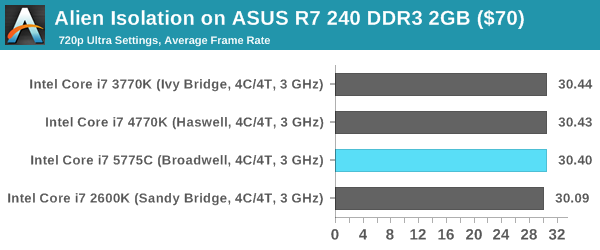
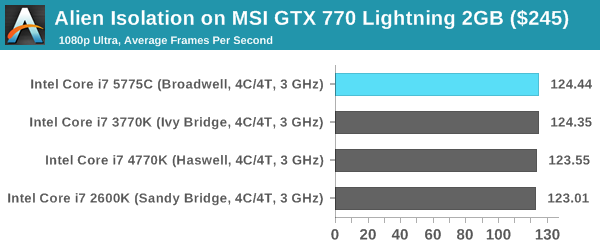
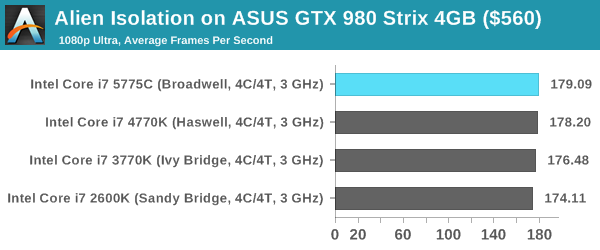
Total War: Attila
The Total War franchise moves on to Attila, another The Creative Assembly development, and is a stand-alone strategy title set in 395AD where the main story line lets the gamer take control of the leader of the Huns in order to conquer parts of the world. Graphically the game can render hundreds/thousands of units on screen at once, all with their individual actions and can put some of the big cards to task.
For low end graphics, we test at 720p with performance settings, recording the average frame rate. With mid and high range graphics, we test at 1080p with the quality setting. In both circumstances, unlimited video memory is enabled and the in-game scripted benchmark is used.
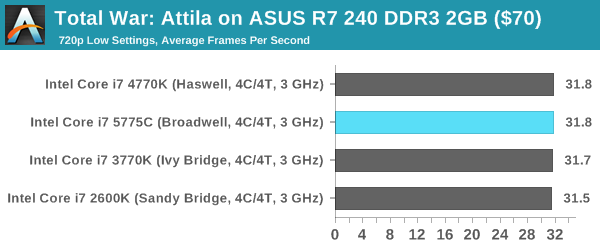

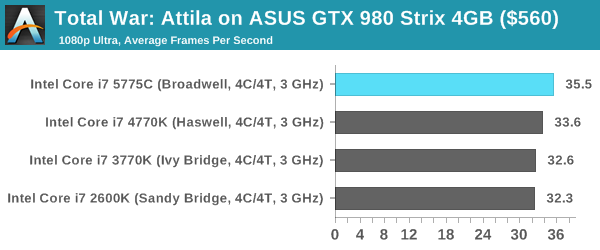
Grand Theft Auto V
The highly anticipated iteration of the Grand Theft Auto franchise finally hit the shelves on April 14th 2015, with both AMD and NVIDIA in tow to help optimize the title. GTA doesn’t provide graphical presets, but opens up the options to users and extends the boundaries by pushing even the hardest systems to the limit using Rockstar’s Advanced Game Engine. Whether the user is flying high in the mountains with long draw distances or dealing with assorted trash in the city, when cranked up to maximum it creates stunning visuals but hard work for both the CPU and the GPU.
For our test we have scripted a version of the in-game benchmark, relying only on the final part which combines a flight scene along with an in-city drive-by followed by a tanker explosion. For low end systems we test at 720p on the lowest settings, whereas mid and high end graphics play at 1080p with very high settings across the board. We record both the average frame rate and the percentage of frames under 60 FPS (16.6ms).
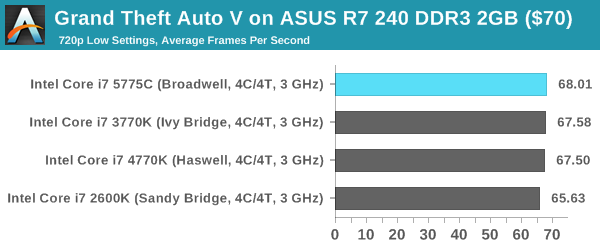
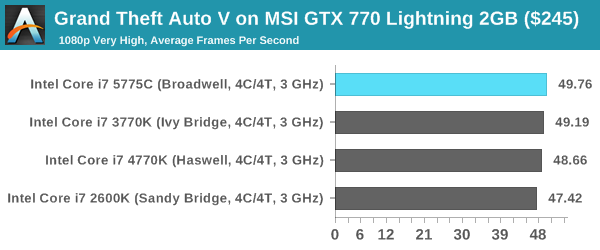
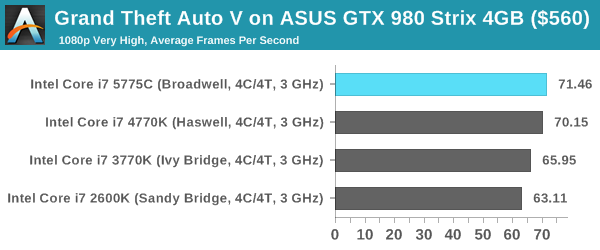
GRID: Autosport
No graphics tests are complete without some input from Codemasters and the EGO engine, which means for this round of testing we point towards GRID: Autosport, the next iteration in the GRID and racing genre. As with our previous racing testing, each update to the engine aims to add in effects, reflections, detail and realism, with Codemasters making ‘authenticity’ a main focal point for this version.
GRID’s benchmark mode is very flexible, and as a result we created a test race using a shortened version of the Red Bull Ring with twelve cars doing two laps. The car is focus starts last and is quite fast, but usually finishes second or third. For low end graphics we test at 1080p medium settings, whereas mid and high end graphics get the full 1080p maximum. Both the average and minimum frame rates are recorded.
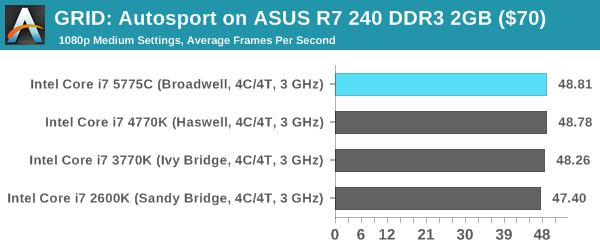

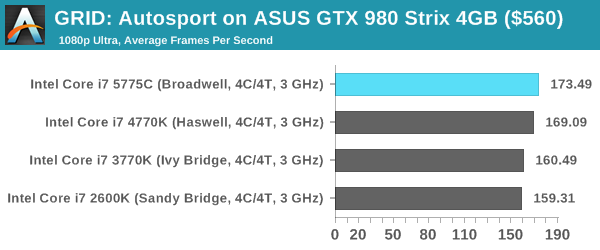
Middle-Earth: Shadows of Mordor
The final title in our testing is another battle of system performance with the open world action-adventure title, Shadows of Mordor. Produced by Monolith using the LithTech Jupiter EX engine and numerous detail add-ons, SoM goes for detail and complexity to a large extent, despite having to be cut down from the original plans. The main story itself was written by the same writer as Red Dead Redemption, and it received Zero Punctuation’s Game of The Year in 2014.
For testing purposes, SoM gives a dynamic screen resolution setting, allowing us to render at high resolutions that are then scaled down to the monitor. As a result, we get several tests using the in-game benchmark. For low end graphics we examine at 720p with low settings, whereas mid and high end graphics get 1080p Ultra. The top graphics test is also redone at 3840x2160, also with Ultra settings, and we also test two cards at 4K where possible.
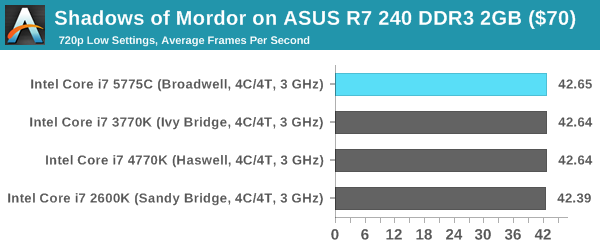
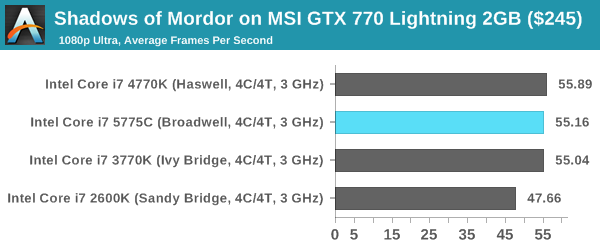
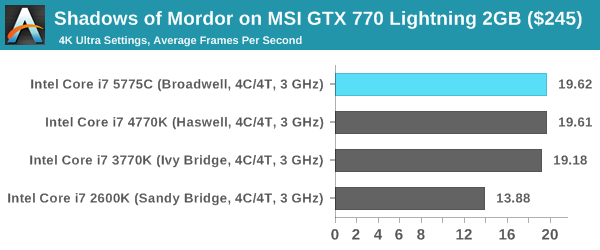

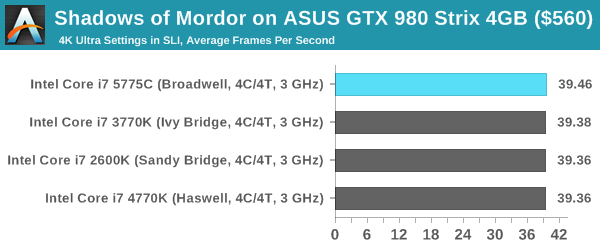

Conclusions on Gaming
From the graphs, it should be clear what the results say. On the whole, we saw 0-5% improvement in the gaming frame rates for these titles compared to Sandy Bridge, although one could consider that the better the graphics card, the bigger the marginal gain:
- With an R7 240, GTA had a 3.6% gain going from i7-2600K to the i7-5775C.
- The GTX 770 gave some odd results with Mordor, but Attila had a 5.5% gain overall.
- On the GTX 980, Grand Theft Auto had a 13.2% gain from the i7-2600K, and Attila saw a 5.7% gain from Haswell to Broadwell.
At the end of the day, the gains in gaming will be down to specific titles. That being said, Grand Theft Auto has been a good example recently of how to write a game (if you have the budget), and if the DX12 methodology can come to involve the CPU more in draw call latency, we might see a bigger generational gain with DX12 titles in the future.















121 Comments
View All Comments
Pissedoffyouth - Monday, August 3, 2015 - link
Can the integrated GPU overclock well? The reason I ask is I have a very micro PC currently with an A10-7800 and I'm looking at getting this badboy to replace itderuberhanyok - Monday, August 3, 2015 - link
you'd have to find one for sale, first.zepi - Monday, August 3, 2015 - link
At least in Europe these are relatively easy to come by in retail.hmind - Wednesday, August 5, 2015 - link
Hey, the answer will more than likely be no, i see no oc tools for igpu overclocking in my pc's z97 bios and my testing on older an intel hd 4600 igpu yeilded no results so i do doubt intel will unlock the igpu, if you can just hold out for the next big apu launch or skylake or get faster ram (which will easily allow the 7800 to catch this chip up if you can get a 2400 mhz kit since kaveri gains a lot from better ram) then you will be sitting pretty, im also sure you can overclock amd igpu's no matter whether or not the cpu is locked so if you haven't already tried it do that.deruberhanyok - Monday, August 3, 2015 - link
Fantastic article! I know more than a few people who will be happy to see there's still no compelling performance reason to upgrade their Sandy Bridge systems. Talk about getting extra bang for the buck!Any chance you might be able to do a quick follow-on post and throw some Nehalem numbers in there? I'm sure there's a few first-gen Core i7 owners wondering if it's worth the upgrade now, or to try and hold off for Skylake.
On a side note, does anyone know when we'll actually be able to buy these Broadwell processors?
Glock24 - Monday, August 3, 2015 - link
Would be nice to have a similar comparison for mobile CPUs, and even more so a comparison of generational improvements of mobile integrated graphics.Marburg U - Monday, August 3, 2015 - link
Still no reason to retire my Q9550@4.8.Marburg U - Monday, August 3, 2015 - link
err: of course it's 3.8.extide - Monday, August 3, 2015 - link
What would you consider worth upgrading for then? I mean a moderately overclocked modern cpu could easily be twice as fast as your setup, not to mention the numerous platform upgrades since...I mean sure, the Q9550 may be fast enough to not be a dog, but there certainly is a lot to be gained...
lukarak - Tuesday, August 4, 2015 - link
But to be gained for what? Back in the day, you had to upgrade, because new content formats were emerging. I distinctly remember buying a PC every two years in the 90's early 00 period. I had a 386, then a 486, then a Pentium 166 (no MMX :), Celeron 333, Athlon 1100, Athlon x64 3200+. The reason I upgraded was the new content. MP3s, DVDs, XviDs, MKVs. All of them weren't able to be played on some of these systems. There was a reason to invest. The i7-920 system I have now for 6.5 years is still going. Sure, there are games, and there is 4k, but 4k is not the jump HD was over DVDs. There just comes a point where you don't notice. Like with smartphones, 150 to 300 ppi, night and day. 300 and 5xx ppi? Not so much. There's just no reason to upgrade if not for numbercrunching or gaming.